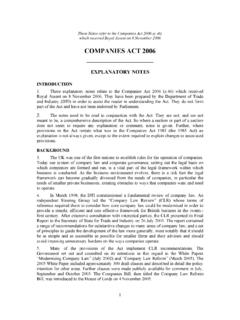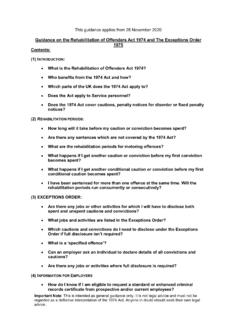Transcription of THE WASTE BATTERIES AND ACCUMULATORS …
1 THE WASTE BATTERIES AND ACCUMULATORS regulations 2009 Government Guidance Notes May 2009 2 Government Guidance Notes 2009 No. 890 1. This Guidance is intended to help those placing BATTERIES and ACCUMULATORS , or products that may contain or incorporate BATTERIES and ACCUMULATORS , on the UK market1, to understand the application of the WASTE BATTERIES and ACCUMULATORS regulations 2009 . The Guidance is also for those that sell portable BATTERIES to consumers, and those collecting, treating, recycling or exporting WASTE BATTERIES , as they also have obligations under the regulations . 2. The Guidance aims to explain the regulations as interpreted by the Department for Business, Enterprise and Regulatory Reform (BERR), the Department for the Environment, Food and Rural Affairs (Defra) and the devolved administrations for Northern Ireland, Scotland and Wales. These regulations affect the whole of the UK.
2 However, there are also supplementary regulations for both Northern Ireland and Scotland addressing specific issues and these are also covered by this Guidance on pages 52-53. 3. In the interests of brevity, in most instances the Guidance uses the words battery or BATTERIES to describe both single use (primary) BATTERIES and rechargeable BATTERIES ( ACCUMULATORS ). (See definitions on page 6.) 4. The regulations themselves should always be read and understood, as they constitute the law. This Guidance is intended to be informative, but has no legal authority. You should refer to the regulations themselves for a full statement of the legal requirements and, in the case of doubt, take independent advice, including your own legal advice. The regulations may be revised from time to time, so businesses that may be affected should take care to keep themselves informed of changes. Such changes will normally be publicised on BERR and Defra websites, but information may also be obtained from the relevant Departments themselves.
3 Details of contacts for further information are given at the end of the document. How to use this Guidance 5. This Guidance is restricted to the application of the WASTE BATTERIES and ACCUMULATORS regulations 2009 that transpose the WASTE battery provisions of the EC Directive on BATTERIES and ACCUMULATORS and WASTE BATTERIES and ACCUMULATORS (2006/66/EC). It deals with 1 Guidance on when a product is deemed to have been placed on the market may be found in section , Placing on the market , of the European Commission s Guide to the implementation of directives based on the New Approach and the Global Approach. the Guide (or Blue Book Guide ) is a guide to the principles to be applied to placing on the Community market but may also be useful as regards placing on the UK market for the first time. 3 requirements related to the collection, treatment and recycling of WASTE automotive, industrial and portable BATTERIES .
4 It includes producer responsibility requirements for those placing new BATTERIES on the UK market and requirements for those selling new portable BATTERIES , or collecting, treating, recycling or exporting automotive, industrial or portable BATTERIES when they become WASTE . There are substantial differences in obligations depending on whether the BATTERIES in question are automotive, industrial or portable; affected parties will need to be clear which type or types they deal with in order to establish how the regulations affect them. 6. The Government has a separate set of guidance notes relating to the BATTERIES and ACCUMULATORS (Placing on the Market) regulations 2008 (SI 2008/2164). Those regulations deal with technical requirements affecting the manufacture, marketing and labelling of new BATTERIES , and the design of certain battery-powered equipment. 4 URN 09/878 Table of Contents BATTERIES regulations THE LAW IN BRIEF.
5 5 ENTRY INTO FORCE .. 5 KEY REQUIREMENTS .. 5 ENFORCEMENT AUTHORITY .. 6 SCOPE .. 6 DEFINITIONS .. 6 EXEMPTIONS .. 12 THE regulations IN DETAIL .. 14 PRODUCER OBLIGATIONS .. 14 Industrial Battery Producers .. 14 Automotive Battery Producers .. 18 Portable Battery Producers .. 22 PORTABLE BATTERY COMPLIANCE SCHEMES .. 27 DISTRIBUTORS OF PORTABLE BATTERIES .. 39 LOCAL AUTHORITIES .. 43 TREATMENT AND RECYCLING OF WASTE BATTERIES .. 44 WASTE BATTERY EXPORTER OBLIGATIONS .. 47 BUSINESS OR OTHER PREMISES WHERE AUTOMOTIVE BATTERIES ARISE .. 50 GUIDANCE FOR BATTERY CONSUMERS .. 50 NORTHERN IRELAND .. 52 THE WASTE BATTERIES AND ACCUMULATORS (CHARGES) regulations (NORTHERN IRELAND) 2009 .. 52 THE WASTE BATTERIES AND ACCUMULATORS (TREATMENT AND DISPOSAL) regulations (NORTHERN IRELAND) 2009 .. 52 SCOTLAND .. 53 CONTACT POINTS FOR FURTHER INFORMATION .. 54 ANNEX A .. 55 FLOW DIAGRAM TO ASSIST WITH DETERMINING BATTERY 55 ANNEX B .. 56 INFORMATION TO BE INCLUDED IN AN APPLICATION FOR REGISTRATION OF PRODUCERS.
6 56 5 BATTERIES regulations the law in brief 7. The WASTE BATTERIES and ACCUMULATORS regulations 20092 (hereafter referred to as the regulations ) implement in the UK the WASTE battery provisions of the EU Directive on BATTERIES and ACCUMULATORS and WASTE BATTERIES and ACCUMULATORS 2006/66/EC (hereafter the Directive ). 8. These regulations set out requirements for WASTE battery collection, treatment, recycling and disposal for all battery types including arrangements by which the UK intends to meet WASTE portable battery separate collection targets of 25% by 2012 and 45% by 2016. Any persons wishing to place on the market new primary (single use) BATTERIES and ACCUMULATORS (more commonly known as rechargeable BATTERIES ), and products that may contain BATTERIES and ACCUMULATORS , should familiarise themselves with these regulations . The regulations also affect battery distributors/retailers, and WASTE battery collectors, recyclers and exporters.
7 9. These regulations supplement the BATTERIES and ACCUMULATORS (Placing on the Market) regulations 2008, which introduced a range of product design requirements, including restrictions on the use of mercury and cadmium in new BATTERIES , new battery labelling requirements and requirements for new appliances to be designed so that BATTERIES can be easily removed. 10. These regulations do not affect the application of other existing legal requirements for BATTERIES such as those regarding safety, the protection of health, existing transport requirements or provisions on hazardous WASTE . In other words, existing legislation that affects BATTERIES and relevant hazardous substances must also be complied with. Entry into force 11. The regulations came into force on 5 May 2009 (with the exception of some provisions listed in Regulation 1(2) which come into force later). Key Requirements 12. The requirements, covered by this Guidance, are broken down into 6 broad areas as follows: (i) Requirements for new battery producers including producer responsibility requirements which mean that battery producers will have to fund the collection, treatment and recycling of WASTE BATTERIES .
8 2 2009 No. 890 6 (ii) Requirements for new battery distributors including requirements for portable battery distributors to have WASTE battery collection facilities. (iii) Requirements for portable WASTE battery collection scheme operators setting out the criteria that battery producer compliance schemes will have to meet. (iv) Requirements for WASTE battery treatment operators. (v) Requirements for WASTE battery exporters. (vi) Advice for consumers and businesses that buy and use BATTERIES . 13. Differing requirements apply in many cases, depending on whether the BATTERIES in question are automotive, industrial or portable. Enforcement Authority 14. Responsibility for the enforcement of these regulations falls mostly to the Environment Agency in England and Wales, the Scottish Environment Protection Agency in respect of Scotland and the Department of the Environment for Northern Ireland.
9 In practice the Northern Ireland Environment Agency (an agency of the Department of the Environment) carries out this enforcement role. These bodies are called the Environment Agencies within this guidance. 15. In addition, Defra will appoint an enforcement body for the obligations which fall on distributors and BERR will itself be the enforcement authority for many of the obligations relating to WASTE automotive and industrial BATTERIES . Scope 16. The regulations apply to all types of BATTERIES and ACCUMULATORS , regardless of their shape, volume, weight, material composition or use, and whether or not they are incorporated into appliances. Definitions 17. A detailed list of definitions can be found in the regulations themselves. The following examples are particularly important when using this guidance: 7 What is a battery? 18. A battery or accumulator is considered to be any source of electrical energy generated by direct conversion of chemical energy and consisting of either one or more primary battery cells (non-rechargeable or disposable BATTERIES ); or one or more secondary battery cells ( ACCUMULATORS or rechargeable BATTERIES ).
10 This Guidance uses the words battery and BATTERIES to mean both primary and rechargeable varieties. What different types of BATTERIES are there? 19. The regulations apply a number of common and a number of different obligations upon persons placing BATTERIES on the market depending on whether these BATTERIES are classified as industrial, automotive or portable BATTERIES . These three different types of BATTERIES are defined in the following way: 20. An industrial battery means a battery or battery pack of any size or weight which is: designed exclusively for industrial or professional uses; used as a source of power for propulsion in an electric vehicle or a hybrid vehicle ( a vehicle with both an electric motor and an internal combustion engine); unsealed but is not an automotive battery or accumulator; or sealed but is not classified as a portable battery. Examples of industrial BATTERIES include: BATTERIES used in offshore oil rigs and lighthouses.






